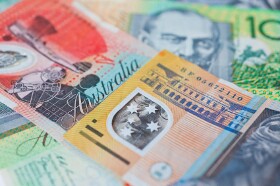
The Australian dollar fell against almost all other most-traded currencies today. Domestic macroeconomic data was unfavorable to the currency as it missed market expectations. The monetary policy statement released by Australia’s central bank today retained an optimistic outlook for the nation’s economy but kept the possibility of additional monetary easing in the cards.
The Reserve Bank of Australia released its quarterly Statement on Monetary Policy today. In it, the central bank maintained its economic forecasts largely unchanged, predicting GDP growth to accelerate to 2.75% over 2020 and to 3% by the end of 2021. Some analysts considered those predictions to be overly optimistic, though. Bill Evans, an analyst at Westpac, commented:
The overview of the RBAâs growth outlook, while largely unchanged from August, still appears to be overly optimistic, particularly around the residential construction cycle and business investment. On the other hand, the downbeat view on wages, inflation and the unemployment rate make it clear that the RBA does not believe that its job is done and so we can expect further policy action from the RBA in 2020. Westpac continues to expect the RBA to cut to 0.50% in February 2020 and to move to unconventional policies at an appropriate time.
Talking about monetary policy, the Statement mentioned considerations against easing the policy further:
In discussing the policy decision in October, the Board was mindful that rates were already very low and that each further cut brings closer the point at which other policy options might come into play. It also took into account the possibility that further easing could unintentionally convey an overly negative view of the economic outlook, or that the usual channels of policy transmission might be less effective at low interest rates.
Indeed earlier this week, the RBA decided to leave its main interest rate unchanged at 0.75%. The Statement explained the decision by the fact that “forecasts imply some progress towards the medium-term inflation and full employment goals” and “global financial markets appear to have passed a trough of pessimism”. Coupled with the previous interest rate cuts, those factors warranted a pause in the easing cycle, and the Statement said:
This allows time to assess the effects of the recent easing of monetary policy as well as global developments.
Nevertheless, the bank stated that it is ready to cut rates even more if it will be necessary:
Given the outlook, the Board is prepared to ease monetary policy further if needed to support sustainable growth in the economy, full employment and the achievement of the medium-term inflation target over time.
Released separately by the Australian Bureau of Statistics, the seasonally adjusted number of home loans rose by 1.4% in September, missing the market consensus of 2.1%. The August increase got a significant positive revision from 1.8% to 2.7%.
AUD/USD declined from 0.6896 to 0.6868 as of 13:14 GMT today. EUR/AUD advanced from 1.6016 to 1.6065. AUD/JPY slipped from 75.37 to 75.13.
If you have any questions, comments, or opinions regarding the Australian Dollar, feel free to post them using the commentary form below.